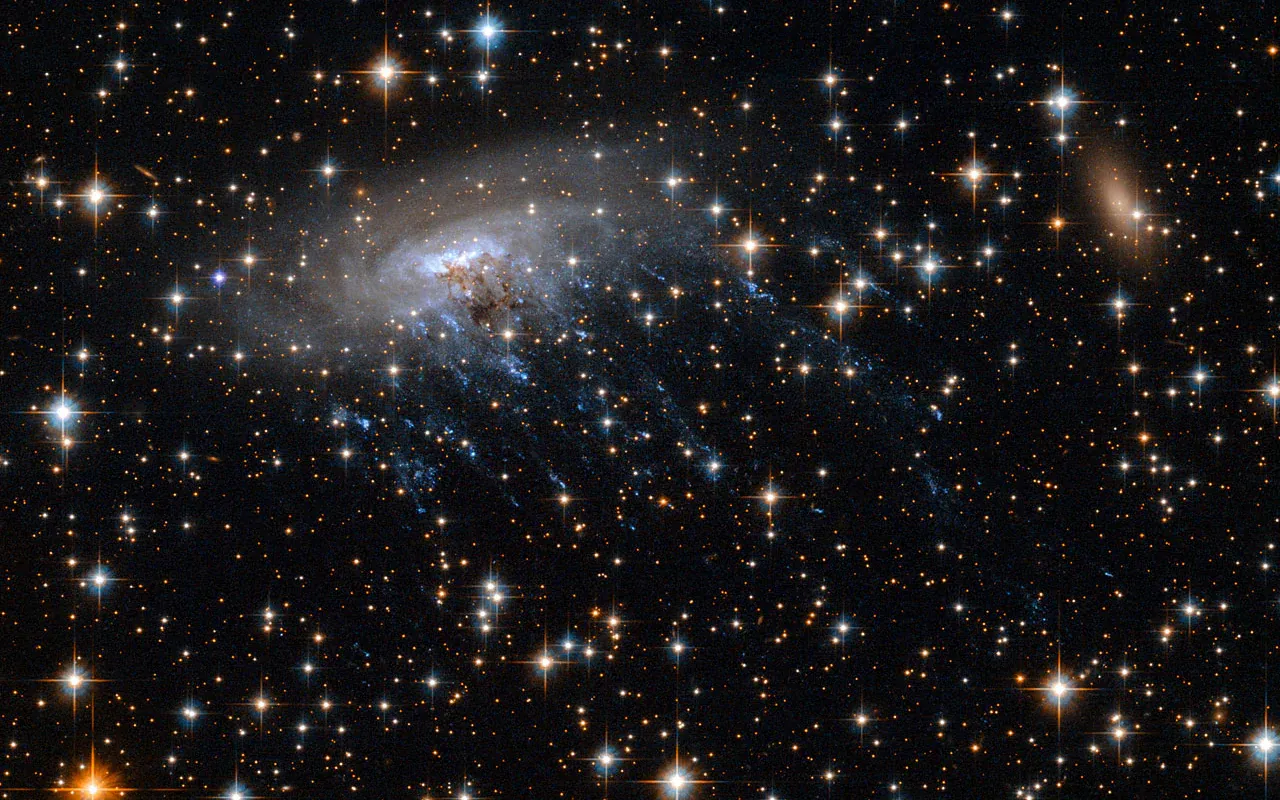The Great Attractor: A Cosmic Enigma Pulling the Universe Together

The Great Attractor beckons, a mysterious force tugging galaxies across the cosmos with relentless power.
Anúncios
Imagine an invisible hand, vast and unyielding, orchestrating the dance of entire galaxy clusters through the void.
This phenomenon, nestled in a region obscured by our Milky Way’s dense starfield, has captivated astronomers for decades.
It’s not just a curiosity—it’s a challenge to our understanding of the universe’s structure, dynamics, and ultimate fate.
What could wield such gravitational might, pulling millions of galaxies toward a single point?
Let’s unravel this cosmic puzzle, exploring its discovery, implications, and the tantalizing questions it raises.
A Discovery Shrouded in Stardust
In the 1980s, astronomers noticed something peculiar: galaxies, including our own Milky Way, were streaming toward a specific region in the sky at alarming speeds.
This wasn’t random motion but a coordinated flow, as if the universe itself were conspiring to converge.
Dubbed the Great Attractor, this anomaly lies roughly 250 million light-years away in the direction of the Centaurus and Norma constellations.
The catch? It’s hidden behind the Milky Way’s “Zone of Avoidance,” a band of gas, dust, and stars that blocks our view.
This cosmic veil makes direct observation tricky, forcing scientists to rely on indirect methods like radio and X-ray surveys to peek through the galactic fog.
The discovery stemmed from meticulous measurements of galaxy velocities.
By studying redshift and blueshift—changes in light wavelengths caused by motion—researchers mapped the peculiar velocities of thousands of galaxies.
They found a consistent drift toward a focal point, with speeds reaching up to 600 kilometers per second.
To put this in perspective, that’s fast enough to cross the Earth’s diameter in about 20 seconds.
This wasn’t just a local phenomenon; it spanned a region affecting structures across hundreds of millions of light-years.
The sheer scale suggested something massive—perhaps a supercluster or even a denser, more exotic structure—was at play.
For more detailed insights into the discovery, you can visit NASA’s official page on the Great Attractor.
What Could the Great Attractor Be?
Picture a cosmic whirlpool, not of water but of gravity, drawing in everything within its reach.
The Great Attractor is likely a colossal concentration of mass, but its exact nature remains elusive.
Early theories pointed to a supercluster, a gathering of galaxy clusters bound by gravity.
Superclusters are the universe’s largest structures, often containing thousands of galaxies and spanning tens of millions of light-years.
Yet, the gravitational pull observed seemed too strong for a typical supercluster, prompting speculation about more exotic possibilities.
One hypothesis suggests a dense filament or wall of galaxies, part of the cosmic web—a network of interconnected structures shaping the universe.
Another posits a role for dark matter, the invisible substance that outweighs visible matter by a factor of five.
Dark matter’s gravitational influence could amplify the region’s pull, acting like an unseen scaffold holding the structure together.
Some even wonder if a primordial black hole or a relic of the early universe could contribute, though such ideas remain speculative.
Each theory pushes the boundaries of what we believe is possible, challenging us to rethink the universe’s architecture.
To illustrate, consider a bustling city at night, its skyline glowing with countless lights.
Now imagine an unseen force pulling every building toward a single point, defying all logic.
That’s the Great Attractor’s effect on cosmic scales—galaxies as skyscrapers, drawn inexorably toward an invisible epicenter.
The analogy underscores the phenomenon’s strangeness: it’s not just about mass but about a force that reshapes our cosmic neighborhood.

+ When Will the Milky Way Collide with Andromeda? Understanding Galaxy Collisions
The Role of the Laniakea Supercluster
In 2014, a breakthrough study led by astronomer R. Brent Tully redefined our understanding of the Great Attractor’s context.
Published in Nature, the research introduced the Laniakea Supercluster, a massive structure encompassing 100,000 galaxies, including our Milky Way, spanning 520 million light-years.
Laniakea, meaning “immense heaven” in Hawaiian, is our cosmic home, and the Great Attractor lies near its heart.
The study used advanced velocity mapping to show that Laniakea’s galaxies are flowing toward this gravitational hub, like rivers converging into a vast basin.
This discovery clarified the Great Attractor’s role as a key node within Laniakea.
However, it also raised new questions.
If Laniakea itself is moving toward the Great Attractor, what lies beyond?
Could an even larger structure, like the Shapley Supercluster—located 650 million light-years away and containing 20 times the Milky Way’s mass—be exerting additional influence?
The interplay between these massive structures hints at a hierarchy of gravitational forces, each pulling on the other in a cosmic tug-of-war.
| Structure | Distance (Million Light-Years) | Estimated Mass (Solar Masses) | Role in Cosmic Flow |
|---|---|---|---|
| Great Attractor | 250 | ~10^15 | Primary gravitational hub for Laniakea |
| Laniakea Supercluster | 0 (contains Milky Way) | ~10^17 | Flows toward Great Attractor |
| Shapley Supercluster | 650 | ~10^16 | Potential secondary influence on Laniakea |
Why Does This Matter?
The Great Attractor isn’t just a distant curiosity—it’s a window into the universe’s past, present, and future.
Its gravitational influence reveals how matter clumps together, forming the cosmic web’s filaments, walls, and voids.
By studying its effects, astronomers gain insights into the universe’s expansion, driven by dark energy, and the counteracting pull of gravity.
The tension between these forces shapes the cosmos’s evolution, determining whether it will expand forever or eventually collapse.
Consider a hypothetical galaxy, “Astraea,” drifting 300 million light-years from the Great Attractor.
Over billions of years, Astraea’s path bends subtly, drawn toward this unseen mass.
Its stars age, new ones form, yet its destiny is tied to this cosmic current.
Now imagine a second galaxy, “Eryndor,” closer to the hub, already orbiting a massive cluster within the Great Attractor’s grasp.
These examples highlight the phenomenon’s universal reach—every galaxy, near or far, feels its pull, reshaping their trajectories over cosmic timescales.
Statistically, the Great Attractor’s influence extends to a region containing roughly 1% of the observable universe’s volume, affecting an estimated 1 million galaxies.
This staggering scope underscores its significance as a gravitational linchpin, anchoring a vast swath of the cosmos.
Yet, its hidden nature keeps it tantalizingly out of reach, fueling both scientific rigor and imaginative wonder.

Challenges in Unraveling the Mystery
Peering through the Zone of Avoidance is like trying to read a book through a frosted window.
Dust and gas scatter visible light, obscuring the Great Attractor’s core.
Astronomers counter this by using wavelengths less affected by dust, such as radio and infrared.
Projects like the ALFALFA survey, which maps neutral hydrogen in galaxies, have helped trace the region’s structure.
Still, gaps remain.
The mass estimates—roughly 10^15 solar masses—are based on gravitational effects, not direct observations, leaving room for uncertainty.
Another hurdle is distinguishing the Great Attractor’s influence from other cosmic flows.
The Shapley Supercluster’s pull complicates velocity measurements, creating a layered gravitational landscape.
Advanced simulations, like those from the IllustrisTNG project, model these dynamics, but they rely on assumptions about dark matter and galaxy formation.
Each new dataset refines our picture, yet the full portrait remains incomplete.
++ Measuring the Cosmos: Unlocking the Secrets of Galactic Distances
| Observational Method | Wavelength Used | Strength | Limitation |
|---|---|---|---|
| Optical Spectroscopy | Visible Light | High-resolution redshift data | Obscured by Milky Way dust |
| Radio Surveys (ALFALFA) | Radio Waves | Penetrates dust, maps hydrogen | Limited to gas-rich galaxies |
| X-ray Imaging | X-rays | Detects hot gas in clusters | Requires massive clusters for signal |
What Lies Ahead?
Could the Great Attractor hold secrets to the universe’s origins?
Future telescopes, like the Square Kilometre Array (SKA), promise unprecedented resolution in radio wavelengths, potentially unveiling the region’s hidden structures.
Machine learning is also transforming how we analyze cosmic flows, sifting through vast datasets to identify patterns invisible to human eyes.
These tools could finally lift the veil, revealing whether the Great Attractor is a supercluster, a dark matter nexus, or something entirely new.
The phenomenon also invites philosophical reflection.
It reminds us that our Milky Way is but a speck in a grand cosmic current, pulled by forces we barely comprehend.
Its study bridges science and wonder, grounding us in data while igniting our imagination.
As we chase answers, we confront the universe’s vastness—and our own curiosity’s boundless reach.
In the end, the Great Attractor is more than a gravitational anomaly; it’s a testament to the universe’s complexity.
It pulls not just galaxies but our collective quest for knowledge, urging us to explore, question, and marvel at the cosmos’s hidden depths.
